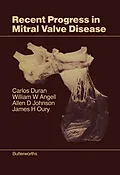Recent Progress in Mitral Valve Disease presents a comprehensive examination of the proceedings that resulted from the International Symposium that transpired in Paris. It discusses the anatomy and physiology of the mitral valve. It addresses the cyclical motion of the mitral valve leaflets.
Some of the topics covered in the book are the cyclical motion of the mitral annulus; analysis of hypertrophic cardiomyopathy; diagnoses of acute myocardial ischemia; characteristics of an abnormally functioning, structurally abnormal mitral valve; atrial function in normal cardiac cycle; and atrial function in acute mitral regurgitation. The factors that modify regurgitant volume are fully covered. An in-depth account of the methods for animal preparation and dynamics of acute experimental mitral regurgitation are provided. The uses and limitations of echocardiography in the examination of the mitral valve are completely presented. A chapter is devoted to the timing of surgical intervention in chronic mitral regurgitation. Another section focuses on the status of prosthetic valves in the mitral position.
The book can provide useful information to doctors, cardiologists, students, and researchers.
Inhalt
Section 1
1 Introduction
2 Historical Perspective of Surgery on the Mitral Valve
Section 2 Flow Dynamics in Mitral Valve Disease
3 Dynamics and Fluid Dynamics of the Mitral Valve
4 Physiology of Mitral Valve Flow
5 A New Approach to Mitral Valve Exploration Using a Two-Dimensional Echo-Doppler Technique
Section 3 The Integrated Function of the Mitral Apparatus, Left Atrium, Mitral Annulus and Papillary Muscles
6 Functional Anatomy of the Mitral Valve and Annulus in Man: Lessons Learned from Echocardiographic Observations
7 Left Atrial Function in Mitral Valve Disease
8 The Dynamics of Acute Experimental Mitral Regurgitation
9 Uses and Limitations of Echocardiography in the Examination of the Mitral Valve
10 Vasodilator Therapy for Mitral Regurgitation
Section 4 the Determinants and Implications of Pump and Myocardial Function in Mitral Valve Disease
11 The Use of Quantitative Angiocardiography in Mitral Valve Disease
12 Adaptations of the Left Ventricle to Chronic Volume Overload and the Problem of Postoperative Afterload Mismatch in Mitral Regurgitation
13 The Timing of Surgical Intervention in Mitral Regurgitation
14 Effects of Acute and Chronic Mitral Regurgitation on Left Ventricular Mechanics and Contractile Muscle Function
Section 5 Surgical Treatment Using Prosthetic Valves
15 The Silastic Ball Valve: a Current Prosthesis for Mitral Replacement
16 The Current Status of Prosthetic Valves in the Mitral Position
Section 6 Surgical Treatment Using Tissue Valves
17 Current Status of the Pericardial Xenograft Valve
18 Current Status and the Future of Tissue Valves
19 the Performance of the Hancock Bioprosthetic Valve over an 11 Year follow-up Period: a Preliminary Report
Section 7 Surgical Treatment Using Reconstructive Techniques
20 Mitral Reconstruction in Predominant Mitral Stenosis
21 Mitral Reconstruction in Predominant Mitral Incompetence
Section 8 Special Considerations in Mitral Valve Surgery
22 Anesthesia for Mitral Valve Surgery
23 Mitral Valve Re-Replacement
24 Mitral Valve Replacement with Coronary Artery Disease
25 IHSS, the Mitral Valve and Its Treatment
26 Thromboembolism after Mitral Valve Replacement
27 Antithrombotic Therapy following Mitral Valve Replacement
Section 9 the Diagnosis and Treatment of Congenital Mitral Valve Disease
28 the Pathology of Congenital Mitral Valve Disease
29 the Pathology of Complete Atrioventricular Orifice
30 Diagnosis, Evaluation and Treatment of Congenital Abnormalities of the Mitral Valve
31 Repair of Complete Atrioventricular Canal
Section 10 Investigational Papers
32 In-Situ Function of the Papillary Muscle in the Canine Left Ventricle
33 Preservation of Restoration of the Mitral Mechanism during Inferior Wall Aneurysmectomy
34 Deceleration of Mitral Flow and the Genesis of Gallop Sounds
35 Pulmonary Function 8 Years After Mitral Valve Replacement
36 Chordal Rupture: Repair or Replacement?
37 the Reconstruction of the Mitral Valve with Stabilized Biological Tissue in 33 Cases
38 the 'Dynamic' Mitral Ring: a New Concept in Treating Mitral Insufficiency
39 Valve Replacement for Chronic Mitral Insufficiency: Long Term follow-up Using Technetium-99m - Pertechnetate Scintography
Section 11
40 Summary and Overview
